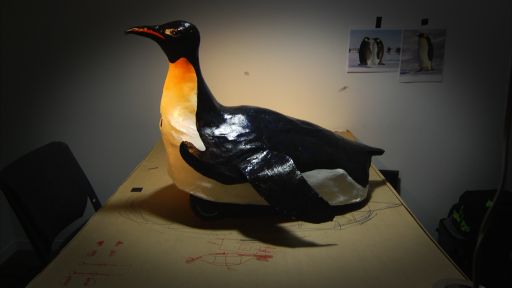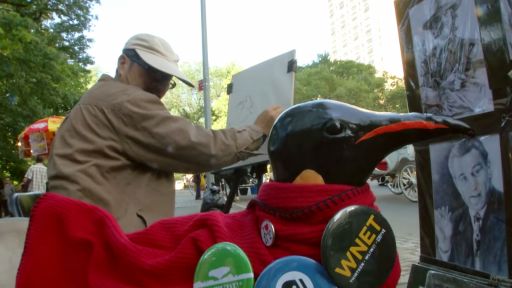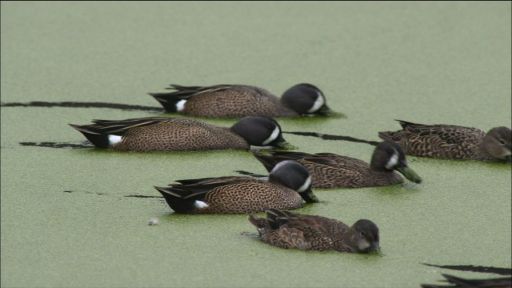Emperor penguins cross a treacherous frozen sea to reach their breeding grounds. Rockhoppers brave the world’s stormiest seas only to come ashore and face a daunting 300-foot cliff, hopping most of the way up. Tropical Humboldt penguins negotiate a gauntlet of dangers to reach their desert burrow nests. The hard work for all the penguins finally pays off when their tiny, vulnerable chicks begin to hatch.
About the Series
The life of a penguin is not an easy one, but recording the challenges faced by nature’s most devoted parents and their offspring in remote parts of the world was nearly as hard, and only possible due to the placement of spycams in their midst. For nearly a year, filmmakers deployed 50 animatronic cameras disguised as realistic life-size penguins, eggs and rocks to infiltrate the colonies of three very different species: emperor penguins in Antarctica, rockhopper penguins on the Falkland Islands, and Humboldt penguins in Peru’s Atacama Desert. The resulting footage shows what it is really like to be a penguin from a whole new perspective.
Series director John Downer (“Earthflight”) and his team filmed 1000 hours of intimate behavior for this project using both animatronic and conventional cameras, footage which was later condensed to three hours for broadcast. Penguins: Spy in the Huddle, A Nature Special Presentation contains a number of notable firsts due to the sheer length of time the production crews spent observing the colonies as well as to the presence of the spycams.
At the cold Antarctic breeding ground of the emperor penguins, emperorcams and eggcams await the arrival of prospective parents. In a humorous sequence, female emperors engage in flipper fights over the more limited pool of potential mates. Even when it’s clear which emperors are officially couples, some female rivals still try to disrupt a pair, sometimes when mating. Later, egg-laying by a female is filmed for the very first time. The footage shows how the mother uses her tail feathers to catch the couple’s single egg while her feet cushion the fall. A dropped egg on the ice would quickly freeze leaving the parents childless.
On the Falkland Islands, rockhoppercams, eggcams and even rockcams capture other firsts, including the underwater arrival of rockhopper penguins battling the stormy South Atlantic seas as they head for dry land. Some rockhoppers are also filmed using mountaineering techniques, rather than hopping, as they struggle to scale the steep rock walls to reach their clifftop nests. On a darker note, pairs that have lost their chicks to predators turn to kidnapping from others in their desperation to find another chick to care for and heated fights ensue.
The shy and rarely-filmed Humboldt of Peru’s Atacama Desert is the only mainland penguin to live in the tropics. At night, low-light Humboldtcams reveal for the first time how hungry vampire bats feed on both adults and chicks while the Humboldts fight back by kicking dirt in their faces. Other sequences show how the penguins maneuver through dangerous booby bird colonies, gangs of fur seals and potentially deadly sea lions to make their way back and forth to their nests from the sea.
With 50 remotely controlled spycams operating in tough environments, there are always mishaps: losing three eggcams in a blizzard or having a rockhoppercam lose its head in an attack by a jealous mate. But when a predator bird mistakes eggcam for the real thing and flies off with it, viewers are treated to the first aerial of a penguin colony shot by a flying bird. The spycams, which captured many first time events and challenges faced by these dedicated parents and chicks, provide new insights into the study of penguin behavior.
Episode 1 “The Journey”
Emperor penguins cross a treacherous frozen sea to reach their breeding grounds. Rockhoppers brave the world’s stormiest seas only to come ashore and face a daunting assault up a 300-foot cliff, hopping most of the way up. Tropical Humboldt penguins negotiate predatory sea lions and vampire bats to reach their desert nests. The hard work for all the penguins finally pays off when their tiny, vulnerable chicks begin to hatch.
Episode 2 “First Steps”
Watched by spycams, newborn emperor penguins in Antarctica are caught walking on their mothers’ feet and taking their own first unsteady steps. On the Falklands, rockhopper chicks meet their unruly and predatory neighbors while eggcams provide unique views of the colony. In Peru, Humboldt chicks take on fur seals and take aim at gulls.
Episode 3 “Growing Up”
As their chicks become increasingly independent, emperor and rockhopper parents place them in a crèche and go fishing. Humboldt chicks are left in their burrows as the adults head for the beach. As the young grow bigger and preen out baby fluff they sport punk hairdos. Emperor chicks go skating while rockhopper chicks practice jumping skills. Eventually, all the chicks leave for the sea, tackling the same hazards as their parents before them, from sea lions to predatory birds, high cliffs to glaciers.



